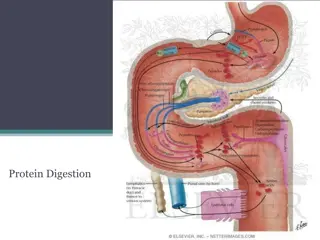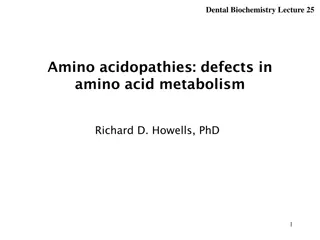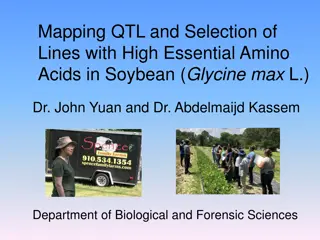Amino Acids: Disposal of Nitrogen
Overview of nitrogen metabolism with a focus on the disposal of nitrogen through amino acid catabolism. It explains the process of removing the α-amino groups from amino acids, the synthesis of urea, and the conversion of carbon skeletons to energy-producing pathways.
36 views • 65 slides
Phylogenetic Analysis of Enzyme Sequences in Plant Species
The content discusses the amino acid sequence alignment and phylogenetic tree analysis of enzyme sequences, specifically DcLCYB2, among different plant species including Daucus carota, Carica papaya, Citrus maxima, Solanum lycopersicum, and Crocus sativus. The study explores the genetic relationship
2 views • 5 slides
Understanding Gene Translation: From RNA to Protein
Gene translation from RNA to protein involves the specific binding of transfer RNA molecules to messenger RNA codons, enabling the translation of nucleotide sequences into amino acids. Each amino acid is attached to a specific tRNA through activating enzymes, and the anticodon on tRNA pairs with the
0 views • 4 slides
Significance of Amino Acids in Biological Pathways
Amino acids play a crucial role as precursors in various biological processes, serving as building blocks for small molecules like hormones, coenzymes, nucleotides, and more. Glycine, a key amino acid, serves as the major precursor for porphyrins, essential in heme proteins. Understanding the pathwa
0 views • 21 slides
Understanding the Relationship Between DNA and Protein Specificity
The relationship between an organism's DNA and protein specificity is intricate. DNA encodes the information for the sequence of amino acids in proteins, thereby determining their specificity. This process involves DNA directing the synthesis of specific RNA molecules, which are then translated into
0 views • 17 slides
Amino Acid Catabolism: Pathways and Reactions
Amino acid catabolism involves removing amino groups via deamination, leading to urea synthesis and TCA cycle intermediates. The process includes transamination and oxidative deamination reactions, with specific aminotransferases catalyzing these reactions. Transamination is a key step in funneling
0 views • 23 slides
Mastering Sequences in Mathematics
Delve into the world of mathematical sequences with this comprehensive guide. Explore what sequences are, different types like arithmetic and geometric, rules for continuing sequences, methods to find specific terms, and understanding position-to-term rules to solve for nth terms efficiently.
0 views • 17 slides
Understanding Pseudo-Noise Sequences and Applications
Pseudo-Noise (PN) sequences are deterministic yet appear random, with applications in various fields such as communication security, control engineering, and system identification. Generated using shift registers, they exhibit statistical properties akin to noise. Linear and nonlinear feedback shift
1 views • 19 slides
Understanding Sequences and Series
Exploring the concepts of sequences and series in mathematics, including definitions, examples, and exercises on arithmetic sequences, geometric progressions, and general terms. Learn about generating sequences, finding nth terms, common differences, and common ratios in different types of sequences
0 views • 20 slides
Discussion on WLAN Sensing Sequence Design in IEEE 802.11-20/1328r0
This presentation by Rui Du from Huawei discusses the design of sequences for WLAN sensing in IEEE 802.11 standards. It covers topics such as existing sequences, analysis of sequences, ambiguity functions, Golay sequences, and properties adopted for communication sequence design.
4 views • 14 slides
Understanding the Urea Cycle in Biochemistry
Explore the intricate process of the urea cycle, its role in removing amino groups from amino acids, converting ammonia into urea in the liver, and managing hyperammonemia. Learn about transamination, oxidative deamination, and the importance of glutamine and alanine in ammonia transport. Discover t
1 views • 26 slides
Understanding Protein Digestion and Amino Acid Metabolism
The process of protein digestion involves proteolytic enzymes produced by the stomach, pancreas, and small intestine. Pepsinogen is activated to pepsin in the stomach, breaking down proteins into oligopeptides and amino acids. After absorption, amino acids are utilized for protein synthesis and as d
0 views • 7 slides
Understanding Amino Acids: Qualitative Tests and Properties
Amino acids play a crucial role as building blocks of proteins and can be converted into specialized products. There are 20 common L-α-amino acids found in mammalian proteins, each with a unique structure and classification based on their side chain properties. Amino acids exhibit optical activity,
1 views • 34 slides
Synthesis of Salicylic Acid: Theory, Derivatives, and Applications
Salicylic acid is synthesized from methyl salicylate through ester hydrolysis with aqueous alkali. It is a versatile compound used in organic synthesis, as a plant hormone, and derived from salicin metabolism. The derivatives of salicylic acid can minimize gastric disturbances and enhance therapeuti
4 views • 12 slides
Amino Acid Metabolism Pathways: Transamination, Deamination, and Clinical Significance of Transaminases
Amino acid metabolism involves pathways such as transamination, deamination, and the clinical significance of serum transaminases like ALT and AST. Transamination involves the transfer of amino groups, while deamination involves the removal of the amino group. Transaminases are important intracellul
0 views • 23 slides
Decarboxylation Reaction and Biogenic Amines in Amino Acid Metabolism
Decarboxylation is a crucial reaction in amino acid metabolism where CO2 is removed to form biogenic amines, catalyzed by decarboxylase enzymes. Important biogenic amines include tyramine, tryptamine, and histamine, each impacting physiological functions like blood pressure regulation. Aromatic amin
0 views • 25 slides
Amino Acid: Structure and Classification Overview
Amino acids are essential building blocks of proteins, with only 20 out of the 300 occurring in nature being used for protein synthesis. The structure of amino acids consists of four groups attached to a central carbon atom. At physiological pH, these groups can ionize, forming zwitterions. Amino ac
0 views • 24 slides
Understanding Transamination and Deamination in Biochemistry
Transamination is a vital chemical reaction in biochemistry that transfers amino groups to ketoacids to form new amino acids, playing a crucial role in amino acid metabolism. Enzymes called transaminases facilitate this process, utilizing -ketoglutarate as a key amino group acceptor. The mechanism i
5 views • 17 slides
Understanding the Structure and Role of Amino Acids in Proteins
Amino acids are building blocks of proteins, with distinct structures and properties. There are 20 common amino acids found in mammalian proteins, each with a carboxyl group, an amino group, and a unique side chain. The side chains determine the role of an amino acid in a protein, classified as nonp
8 views • 11 slides
Understanding Gene Mutations and Their Impact on DNA Sequences
Gene mutations are changes in the nucleotide sequence of DNA, leading to potential amino acid alterations in proteins. These mutations can occur due to replication errors or external factors like chemicals and radiation. Different types of mutations, such as base substitutions, transitions, transver
0 views • 11 slides
Understanding Amino Acids: Structure, Properties, and Classification
Amino acids are essential building blocks of proteins with unique structures and properties. They contain both carboxyl and amino groups, playing vital roles in metabolism. This article covers their general structure, zwitterion form, isoelectric point, pK values, and classification based on body re
0 views • 24 slides
Amino Acid Absorption Mechanisms in Small Intestine
Amino acid absorption in the small intestine is an active process requiring energy derived from ATP hydrolysis. It involves two main mechanisms: carrier proteins transport system and glutathione transport system. The carrier proteins transport system uses ATP energy for absorption, while glutathione
0 views • 18 slides
Understanding Amino Acids: Structure, Classification, and Properties
Amino acids are crucial chemical units that form proteins and play essential roles in the body. They consist of a carboxyl group and an amino group, serving as building blocks and metabolic intermediates. This article covers the general structure, zwitterions, isoelectric point, pK values, and class
0 views • 26 slides
Understanding Amino Acids, Peptides, and Proteins in Organic Chemistry
Amino acids, peptides, and proteins are essential components in biological processes. Proteins are polymers made up of amino acid units linked by peptide bonds, while peptides are important in various biological functions. The structure and classification of amino acids play a vital role in the stru
0 views • 15 slides
Plant Enzyme Activities and Phylogenetic Analysis
The content discusses the alignment of various plant enzyme amino acid sequences, including DcLCYB1, DcLCYB2, and DcLCYE, among different inbred lines. It also explores the construction of DcLCYs for enzyme activities using an E. coli complementation assay. The phylogenetic relationship between DcLC
0 views • 5 slides
Sequences and Patterns in Mathematics
Dive into the world of sequences and patterns with examples and exercises involving identifying patterns, writing formulas, and graphing terms on coordinate planes. Explore different scenarios and learn to express nth terms in sequences. Understand the importance of indexing terms and using proper f
0 views • 48 slides
Understanding Integer Sequences and Terms
Explore the concepts of integer sequences, including infinite and finite sequences, terms of a sequence, and nth term formulas. Learn to classify sequences as finite or infinite and find specific terms in a sequence. Gain a comprehensive understanding of notation and terminology used for describing
3 views • 23 slides
Exploring Sequences and Patterns in Mathematics
Dive into the world of sequences and patterns by exploring expressions, common differences, and nth terms. Discover how to create sequences with specific common differences, identify terms within sequences, and use Venn diagrams to visualize different scenarios. Uncover the rules for constructing nt
0 views • 13 slides
Optimizing CHO Bioprocesses with Amino Acid Prediction Tool
University of Massachusetts Lowell has developed a genome-scale model for Chinese Hamster Ovary (CHO) cells, enhancing bioprocess optimization. The Amino Acid Level Prediction Tool complements this, aiding in predicting key nutrient levels for improved process control. Supported by advanced algorith
0 views • 21 slides
Qualitative Tests of Proteins & Amino Acids: Overview and Analysis
In this lab, you will delve into the qualitative tests for proteins and amino acids, understanding their structures, classifications, and importance in food and human nutrition. The tests include solubility tests and identification tests for both amino acids and proteins, revealing their presence an
0 views • 13 slides
Qualitative Tests of Proteins & Amino Acids - Lab Analysis Overview
This lab analysis covers qualitative tests for proteins and amino acids, including solubility tests and identification tests for amino acids and proteins. Specific tests like Ninhydrin test for -L amino acids, Xanthoproteic test for aromatic amino acids, and lead sulfite test for sulfhydryl group de
0 views • 13 slides
Qualitative Chemical Reactions of Amino Acid Protein Functional Groups
Qualitative chemical reactions of amino acid protein functional groups involve detecting the presence of peptides (proteins) in a sample through tests like the Biuret test. Different reactions, such as the effect of salt concentration on protein solubility and precipitation of proteins by acids, hel
0 views • 14 slides
Understanding Inborn Errors of Amino Acid Metabolism
Explore the world of inborn errors of amino acid metabolism through lectures by Dr. Sumbul Fatma. Discover conditions like Phenylketonuria (PKU), Maple Syrup Urine Disease, Albinism, and more, caused by enzyme deficiencies due to gene mutations. Learn about classical PKU, hyperphenylalaninemia, and
0 views • 25 slides
Overview of Amino Acidopathies in Dentistry: Defects in Amino Acid Metabolism
This lecture discusses the various amino acidopathies, including phenylketonuria, albinism, alkaptonuria, maple syrup urine disease, and homocystinuria. It covers the metabolic defects in amino acid metabolism, symptoms, causes, and treatment methods for these disorders. Emphasizing the importance o
0 views • 19 slides
Understanding Amino Acids: Structure, Types, and Importance
Amino acids are essential organic molecules that serve as the building blocks of proteins. They contain unique chemical groups and play crucial roles in various bodily functions. This article discusses the structure of amino acids, their different types (D and L), and highlights their importance in
0 views • 11 slides
Mapping QTL and Selection of Soybean Lines with High Essential Amino Acids
Soybean (Glycine max L.) plays a crucial role as a crop in North Carolina, especially for its essential amino acids content critical for human and animal nutrition. This study aims to identify quantitative trait loci (QTL) for essential amino acids in soybean seeds using a genetic map from the Forre
0 views • 4 slides
Investigating the Role of Amino Acid 381 in BK Channel Clustering
The study explores the significance of amino acid 381 in the function of dystrophin to localize SLO-1 in C. elegans. By utilizing the T381I mutation, the research aims to determine whether a SLO-1 BK channel with this mutation exhibits a clustered or non-clustered phenotype. Proposed methods involve
0 views • 17 slides
Understanding the Genetic Code and Protein Synthesis
Explore the fascinating world of nucleic acids, DNA, RNA, and the genetic code. Discover how the sequence of nucleotides in mRNA translates into amino acids, forming proteins. Learn about codons, ribonucleotides, and the triplet code, and unravel the process of reading the genetic code to determine
0 views • 20 slides
Understanding Serum Uric Acid Levels and Hyperuricemia
Serum uric acid is a crucial marker of purine metabolism, with elevated levels indicating hyperuricemia which can lead to conditions like Gout. The measurement of serum uric acid helps in diagnosing hyperuricemia, with serum being the preferred specimen for testing. Various factors such as diet, gen
0 views • 12 slides
Understanding Fatty Acid Metabolism in Animals
Animals cannot convert fatty acids into glucose due to the inability to synthesize glucose from fatty acids. The process involves acetyl-CoA not being converted into pyruvate or oxaloacetate, leading to the citric acid cycle and differences between fatty acid synthesis and degradation pathways. Key
0 views • 8 slides







































